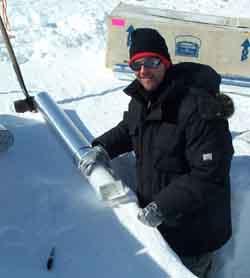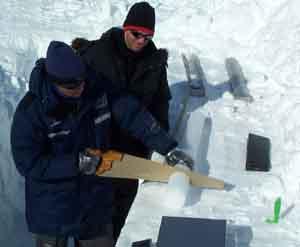7 May, 2003
Weather: -26F, mainly clear skis and great sun at 8:00am
Camp Life: The sleeping bag is working as best it can! I have been warm enough to shed a few layers each night. Each morning the frost layers build up inside the tent and around the area of my bag were my breath hits. I fill my sleeping bag full of batteries, wet socks and boot liners so when I wake up they are dry and working. I have been using wet wipes to clean my face and pits but if I forget to put them in my sleeping bag they are frozen solid! I have only forgotten once.
Along with the wind, our tents have been drifted in so we have had to dig them out a few times this week. Each day the views are amazing. The blowing snow and drifts are always changing making each minute a little different.
Ice Core Processing
Yesterday I explained how drilling of ice cores takes place. Once the ice core is brought up to the surface it needs to be processed. Processing is more or less organizing the ice cores from shallow to deep making sure not to flip the core upside down. Each core is carefully bagged in plastic and placed in a protective tube and box, which is then sent to Colorado to be cut. Contamination and mixing up the tubes is of utmost importance. To keep contamination to a minimum handlers must were plastic gloves and no one is to touch the tubes without them.
During the processes each tube is measured in centimeters and the mass is also record to determine the density of the ice. The deeper you go the denser the ice is. At a certain depth the ice cannot get any more dense. It has been squished as much as it can. When all of the ice has been collected the tubes should be able to fit end to end. Today we finished drilling in one site and drilled to 150m.

Lars with a core sample.

Dr. Greg Lamorey along with Ryan Banta are cutting cores. Cores need to be around 1m so often times need to be cut and placed with shorter cores.

This is Ryan Banta bagging an ice core. Hi Bridgete --
Contact the TEA in the field at
.
If you cannot connect through your browser, copy the
TEA's e-mail address in the "To:" line of
your favorite e-mail package.
|
